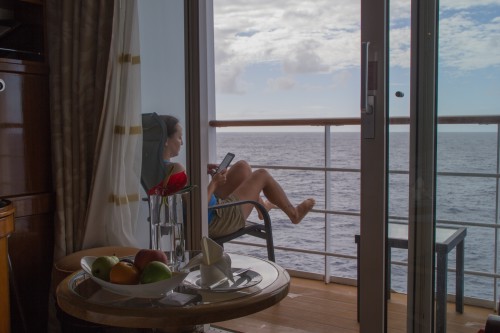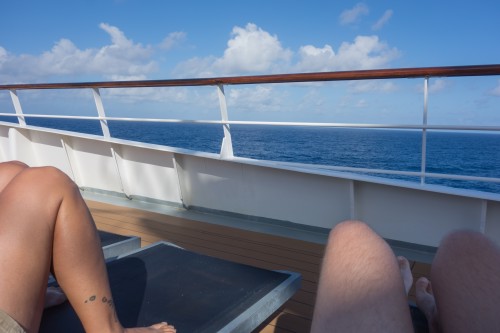

We got up early again, before 6:00 am even with our 30 minute time change from the Tuomotus to the Marquesas. We were unaware they had a different time zone. But the upside was that breakfast seemed 30 minutes earlier than before. We used some Tagalog again with the crew, and so they chatted us up, asking about Crystal's Hawaii tattoo. We figured we should try to use our "fame" to see if we get our hands on some good Filipino food - which the crew are undoubtedly eating but isn't on any of our menus - by asking if they ever serve any Filipino food like pancit or lumpia. They told us to ask one of the head waiters, and they could probably make it happen. After breakfast we went to the piano bar for some peace and quiet so that we could check out pictures and videos from Fakarava and catch up on the trip log. Then we went up to the pool bar to rehydrate with several glasses of water.
At 10:00, we went to another talk by Mark Eddowes, this time on the subject of the Marquesas. He explained that a lot of Polynesia is based on the spread of Tongan and Samoan peoples, with Marquesas being largely Tongan. Nowadays, Tongan and Samoan cultures aren't huge fans of one another. But way back when, a lot of Samoan culture was borrowed from Tongan. Most of Polynesia speaks a language that is largely based on Samoan, except for the Marquesas, where the language is strongly Tongan.
The Marquesas environment is different from a lot of the rest of Polynesia. First, the water is colder, because of the remnants of the Humboldt current that comes up front Antarctica up the coast of South America, turns where Peru juts out to the west, heads past the Galapagos, and ends around the Marquesas. Second, the mountains jut right up out of the water (like Hawaii), so there is very little shallow water. For both of those reasons, deep sea fishing was necessary for the people living there. Also, because of the hilly topography, there was very little area for farming, since the was almost no flat land. So the Marquesans learned to terrace the hillsides.
The Marquesans got their name from the wife of a viceroy in Peru, who sponsored a Spanish trip out there to look for gold. Since there was no gold, the Spanish did very little in the Marquesas, so it wasn't really until Cook arrived in the 1770s that much was known about the area or the people. In 1774, the chief was Tehonu on Tahuata island. The chief structure for the islands was hierarchically based. The oldest sons of the preexisting chief would be the paramount chiefs, and the younger sons would be chiefs of "lesser" communities on the island. While hierarchical, this could be adjusted via warfare, i.e., moving on up by taking out a "higher" chief. All of the chiefs would have a toko toko, which is a large staff/walking stick, and an incredibly ornate fan. They also wore a kilt made of the hair of all the men he'd killed in battle, and a headress made of bird feathers. Meanwhile, the women were known for being the most beautiful in all of Polynesia. The second born sister of the high chief wore headresses from her male ancestors, something that was unique to the Marquesas - as in other lands it very taboo for a female to even touch, let alone wear, those male objects.
In the villages, there would be a communal house for the warriors in the center, with the houses of the chief close nearby. Further from the center would be homes of the "ordinary" people. The tohua was the massive assembly grounds for the community, and was built on large stone platforms. Compared to other Polynesian societies, the Marquesas was quite democratic, and everyone was welcome at the tohua. Warriors were central to the culture, but males could "opt out" at a ceremony in front of the whole community where they renounced their male background and took on a female role in society. Tattooing was a major part of culture as well. Girls would have their first tattoo on their right hand - the hand used to make food for the community. Boys would start around their waist, arround the time they were on their first battle. And then it would go from there, all over the place, with new tattoos recognizing the family, major events, major battles, and so on. It took many years for the tattoo process to be completed. For the highest ranking males that were the most experienced warriors, by the time they were at the end of their lives, they were effectively all black, including the inside of the gums.
Breadfruit is at the center of Marquesan food. They developed lots of different varieties for different tastes and textures. Since it is full of starches, the Marquesans are large people. The Marquesans settled the southeast part of Polynesia (Rapa Nui, Pitcairn, Ducie) as well as Hawaii, so they were definitely long-distance travelers. Everything was seemingly quite good in the Marquesas when Cook arrived, with abundant food, no communicable diseases, and strong communities. The Marquesas went to shit when French came in the mid 1800s. Disease decimated the population, perhaps by 90%. This led to depression in the remaining people, and because of depression and because of the lack of population, a lot of traditional habits ceased. Furthermore, everyone dropped the traditional religion because white people were healthier, wealthier, and told locals they were poor because of their idolatry; this seemed eminently reasonable to the locals, so they took up Christianity in short order. The Marquesas are coming back a bit now, and but for being part of French Polynesia would certainly be their own small country, like Tonga or Samoa.
 |
 |
After the talk, we went to lunch at Le Verandah, outside on the rear deck. It was nice outside, but a tiny bit cool because of a steady breeze. To warm up, after lunch we went up to the pool deck on the 8th floor, and got in some sun. At 2:00, Justin convinced Crystal to join him at a botanic talk. It is amazing that there are plants at all in Polynesia, since it is so far from any continents. Plants to get to Polynesia in three main ways - 1) wind, 2) water, or 3) migrating birds. For the wind-borne seeds, obviously they need to be very light and also able to withstand cold temperatures (since they get blown so high into the atmosphere). For plants that traveled via water, they need to have seeds that can withstand saltwater for long periods of time, with a coconut being the most well-known example. French Polynesia has 880 native plants, 546 of which are endemic. Some of the plants the speaker discussed were:
 |
 |
The talk ended a little after 3, and we went up to the top deck on 9 to read in the shade. It was super windy up there, however, so we didn't stay long. We headed down to an ostensibly sheltered location on 8, where we played Scrabble in the wind. Thankfully the travel Scrabble board has raised squares that the letters clip into - no sliding around. After that we watched sunset, and actually saw a small green flash, Crystal's first. Then we got cleaned up and at at Le Etoile. Dinner was good, but we were super tired, and we discussed how we weren't going to last much past dinner. On the way out we grabbed some candied ginger the boat staff had laid out for the passengers, to help with motion sickness. It actually helped, as we felt much better afterwards (not that we felt awful before). We had some drinks at the piano bar and chatted with the staff again, then at 10pm went up to La Palette where they had a karaoke going on. Next thing we knew it was 11pm, and somehow we were still awake. But not for much longer, as at 11 they stopped karaoke and started a disco, and the whole room emptied out. Perhaps they should rethink what events they have scheduled, and when. Or perhaps that was the plan, to empty everyone out at 11. Either way, we were probably asleep by 11:05.